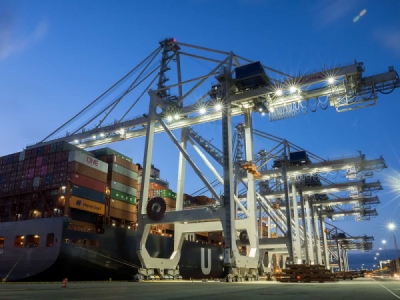
Posted on June 6, 2019
Fourth largest U.S. port looks to usurp West Coast gateways for Midwest box volumes.
The Port of Savannah aims to boost its market share of freight moving into the U.S. Midwest, saying it offers a cheaper way into the Gateway of the West than the West Coast gateways.
To that end, the Georgia Ports Authority (GPA) said on May 31 that it is forming a partnership with the St. Louis Regional Freightway, a group aiming to promote Midwest logistics hubs, to develop unit train service between Savannah and St. Louis.
Anheuser-Busch InBev (NYSE: BUD) and Emerson Electric (NYSE: EMR) are among the shippers represented at the St. Louis Regional Freightway.
The partnership comes as the first part of the Mason Mega Rail Terminal is slated to come online by the end of 2019.
Once complete, the project will double intermodal capacity out of Savannah’s Garden City marine terminal to 1 million containers annually.
Mega Rail will give CSX (Nasdaq: CSX) and Norfolk Southern (NYSE: NSC) the ability to build 10,000-foot long unit trains. Each unit train is capable of carrying 360 forty-foot containers.
Mega Rail is part of a larger $2.5 billion project that will bring Savannah’s total container handling capacity to 8 million twenty foot equivalent (TEU) containers, up from current capacity of 5.5 million TEU, over the next decade.
John Trent, who directs operations for GPA, said both CSX and Norfolk Southern route cargo to the Midwest through Savannah and have double-stack train service. But “current volumes do not merit a unit train at this time. That is the purpose of this partnership, to develop a low-cost and competitive service using the Savannah intermodal gateway.”
At stake is the large amount of discretionary cargo that can move through any port. Most of the volumes moving into the U.S. Midwest are still coming through West Coast ports, and hauled inland by BNSF (NYSE: BRK.A) or Union Pacific (NYSE: UNP).
Trent said a Savannah transit for an international container into the U.S. Midwest could save between $300 and $400 per container compared to intermodal service from West Coast ports.
The transit time would roughly be the same. Ocean shipping would take between four and six days longer to Savannah than to the West Coast. But GPA officials have said the Midwest would be a one-day rail trip compared to a three- or four-day trip from the West Coast.
Trent said the gateways being used by shippers now “are experiencing issues related to volume and with our hyper-productive terminal services, rail miles to St. Louis, and reliability, we are positioned to provide the steamship lines and beneficial cargo owners with an excellent alternative.”
More shippers appear to be tapping Savannah to bring in their containers. Year-to-date imports at Savannah are up some 11 percent at 721,298 TEU.

Despite the overall slowdown in intermodal freight, the intra-Southeast region saw the best growth in the first quarter, according to the Intermodal Association of North America (IANA). The Southeast saw intermodal volumes rise 8.7 percent compared with a year ago.
International container volume showed an even bigger gain of 16 percent, offsetting declines in domestic and trailer volumes.
The Midwest-Southwest intermodal lane, in contrast, saw volume fall 5 percent in the first quarter, with international container volume showing the biggest drop. IANA said some of the decline may be related to imported freight remaining in warehouses as well as weather-related issues hitting Midwest rail networks.
Source: freightwaves.com





